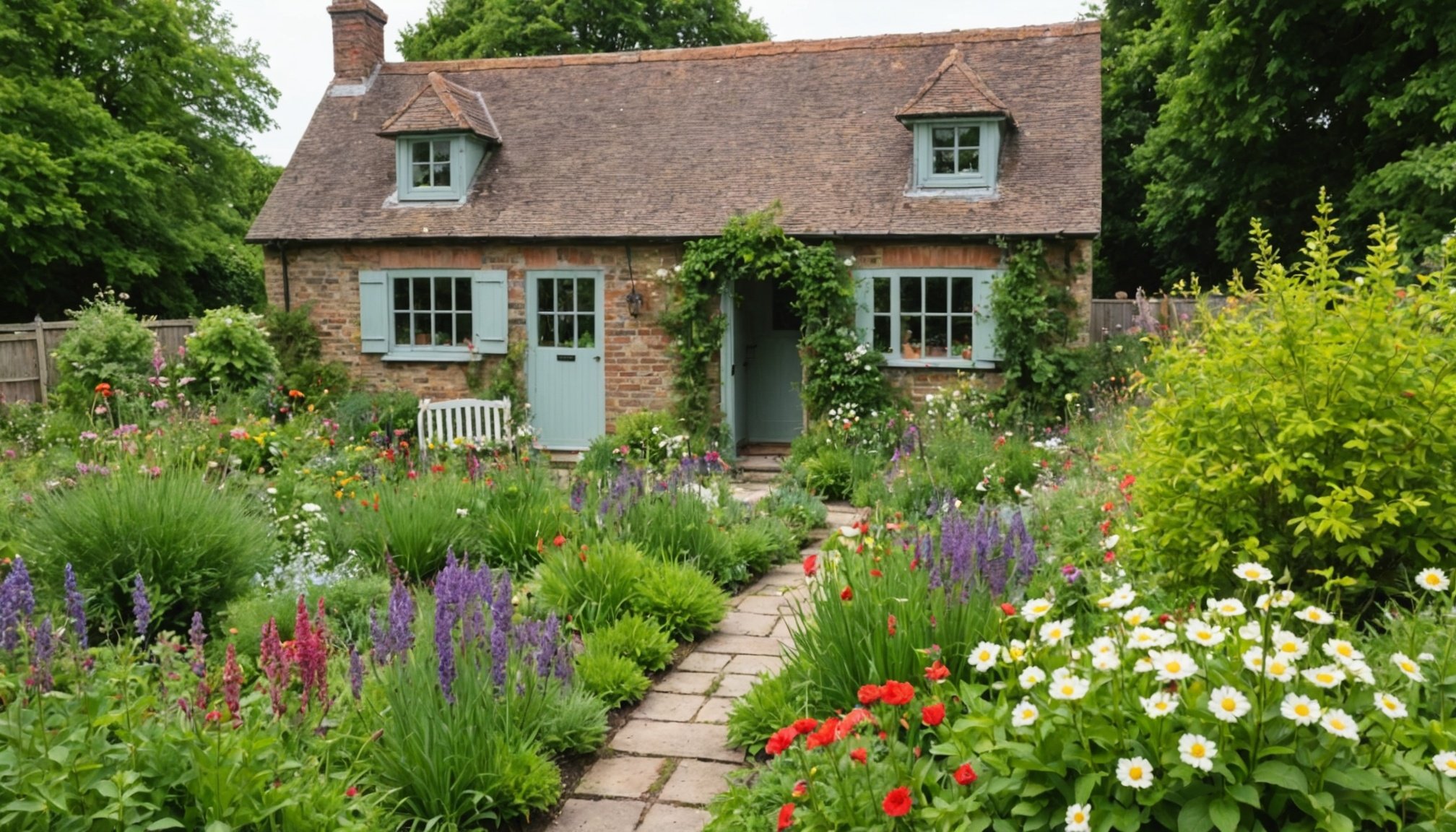Understanding Your Overgrown Cottage Garden
Before diving into a restoration project, garden analysis is crucial in assessing the extent of overgrowth and identifying specific restoration challenges. Knowing the exact state of your garden enables precise planning and decision-making.
First, evaluate the level of overgrowth. Identify invasive flora that might have overtaken the original plants. This evaluation will help outline which plants need to be removed to restore the intended aesthetic. Additionally, examine the current layout in relation to original garden designs, accounting for any existing elements like pathways or arches that may need enhancement or reconstruction.
A lire en complément : Top Organic Fertilizers for Thriving Vegetable Gardens in the UK: A Comprehensive Guide
Next, assess the soil conditions, as these heavily influence which plants can thrive. Investigate for signs of nutrient deficiency, pH imbalances, or compaction issues that could affect plant growth. Soil restoration might involve testing and amending, improving drainage, or rebuilding soil health through organic matter.
Also, study the climate factors influencing your garden. Understanding local weather patterns, such as rainfall or sunlight variations, helps in selecting the right plants, contributing to sustainable garden maintenance.
A découvrir également : Top Natural Solutions to Combat Rose Black Spot in Humid UK Climates
Lastly, recognise plants that were originally part of your cottage garden. Identifying these survivors can guide decisions about which species to nurture, considering their compatibility with both soil and climate conditions. By focusing on these aspects, you can effectively manage an overgrown cottage garden and restore its charm.
Essential Tools and Materials for Restoration
To achieve successful garden restoration, having the right gardening tools and materials is crucial. Whether you’re tackling a small patch or a vast garden space, an equipment checklist helps keep you organised.
Hand tools such as trowels, pruners, and spades are essential. They assist you in planting, pruning, and maintaining the garden. For larger tasks, machinery like rototillers or lawnmowers can be valuable assets, especially in saving time and effort.
Sustainability is key to modern gardening. Thus, choosing eco-friendly restoration materials like organic compost and reclaimed wood ensures that your garden thrives without harming the environment. Opting for such materials supports ecological balance and promotes biodiversity.
Safety equipment is often overlooked but should never be underestimated. Using protective gear such as gloves, goggles, and sturdy boots is critical to prevent injuries. No task is ever worth risking your safety, so ensure that your safety regimen is as robust as your equipment checklist.
Remember, the right combination of tools, materials, and safety measures enhances efficiency and protects the garden and its caretaker. With these elements in place, you can proceed confidently, knowing you’re equipped for any gardening challenge.
Step-by-Step Guide to Clearing Overgrowth
Clearing overgrowth from your garden efficiently requires a comprehensive approach. Garden cleanup involves an initial preparation process to ensure successful results without unnecessary effort.
Initial Assessment and Planning
To begin the garden cleanup, conduct an initial assessment of the overgrown area. Identify the types of plants and weeds present, which will inform your approach. Planning the preparation process involves prioritising tasks based on the density and type of overgrowth. Create a checklist and gather necessary tools such as pruning shears, gloves, and waste bags. Allocating time and resources effectively prevents delays and helps maintain motivation.
Techniques for Clearing Dense Areas
Clearing dense overgrowth requires specific techniques. For heavily overgrown areas, use pruning shears or a hedge trimmer to cut back larger foliage. Start with the tallest plants and work your way down to ensure visibility and access. For smaller areas, hand-pulling weeds is effective but ensure you remove roots to prevent regrowth. Clearing overgrowth may also involve the careful use of herbicides; however, always follow environmental safety guidelines to minimise harm to your garden ecosystem.
Safe Disposal of Waste
After clearing overgrowth, dispose of garden waste responsibly. Environmentally friendly methods include composting organic material like leaves, twigs, and grass clippings. For larger quantities or waste unsuitable for composting, consider city disposal services or garden waste recycling facilities. This approach aids in reducing landfill burden and supports sustainable gardening practices.
Reintroducing Structure and Design
Creating a cohesive garden design that complements cottage aesthetics involves careful planning of the landscape layout. This process begins with defining key structural elements that will enhance both form and function. Paths and borders can serve as transitions between different areas, guiding visitors through the garden while maintaining both order and flow.
Paths play a significant role in establishing the garden’s structure. They not only delineate room-like spaces within the garden but also provide a practical means of traversing the area. Materials for paths can vary, from traditional cobblestones to more rustic options like woodchips or gravel, allowing for personalised touches that reflect the cottage’s aesthetic.
Incorporating focal points such as a classic water feature or strategically placed specimen plants adds depth and intrigue to the garden design. These elements can act as visual anchors, drawing attention and providing interest throughout the seasons.
Another vital component is the preservation of historical garden features. Maintaining these elements respects the garden’s original intent and charm, offering a sense of continuity and heritage. Historical accuracy in planting schemes and hardscape features can blend seamlessly with contemporary enhancements, ensuring that the garden remains both relevant and reverent to its past.
Plant Selection for Restoration
Selecting appropriate plants is crucial for the success of any restoration project. Consider these plant recommendations that enhance biodiversity and aesthetic appeal within cottage gardens.
Native Plants and Biodiversity
Native plants play a significant role in restoration, promoting biodiversity by providing habitats for local wildlife. They are adapted to local conditions, requiring less maintenance and fewer resources like water and fertilizer. In UK cottage gardens, plants such as Primula vulgaris (primrose) and Digitalis purpurea (foxglove) are recommended for their ecological benefits and delicate blooms.
Flowering Plants for Color
To achieve vibrant year-round interest, select seasonal planting that showcases flowering plants. Lupinus (lupin) and Campanula (bellflower) are ideal choices, providing eye-catching hues and prolonged blooming periods. By incorporating these plants, gardens have continuous points of interest across different seasons, adding both beauty and life.
Foliage and Perennials for Texture
Incorporating a mix of textures and heights not only enhances visual appeal but also adds depth to any landscape. Consider perennials like Hosta and Heuchera for bold foliage and varied leaf patterns. These plants complement flowering varieties and offer structural diversity, crucial for the dynamic nature of cottage gardens. Adjusting the plant mixture according to seasonal planting further optimizes visual interest.
Implementing Sustainable Gardening Practices
Incorporating sustainable gardening practices ensures a healthier garden while conserving resources. One key method is using organic fertilizers, which promote plant growth without harming the environment. Unlike chemical alternatives, these fertilizers improve soil health by adding nutrients and enhancing the soil’s natural structure.
Effective pest control in sustainable gardening involves eco-friendly methods, such as introducing beneficial insects that prey on harmful pests. This approach minimizes chemical use and maintains ecological balance.
Water conservation is crucial for eco-friendly practices. Strategies such as rainwater harvesting and drip irrigation help reduce water usage. By storing rainwater, gardeners can utilize it during dry periods, lessening reliance on municipal water supplies. Drip irrigation, which delivers water directly to plant roots, minimizes evaporation and runoff, maximizing water efficiency.
Ensuring biodiversity in the garden can be achieved through companion planting. This practice involves growing plants in proximity for mutual benefits, such as pest control and pollination support. For example, planting marigolds alongside vegetables can repel nematodes, enhancing crop resilience. Companion planting not only supports biodiversity but also reduces the need for synthetic interventions.
Adopting these eco-friendly practices helps create a sustainable garden, fostering soil health and ecosystem vitality. By integrating these methods, gardeners contribute to environmental conservation and resource efficiency.
Seasonal Considerations for Garden Restoration
In the realm of seasonal gardening, timing is everything. The UK’s unique climate demands gardeners pay close attention to the UK gardening calendar for effective garden restoration. This ensures that plants not only survive but thrive.
Spring: Best Time for Planting
Spring heralds new beginnings and is the best time for planting. This season offers the perfect blend of temperature and moisture, fostering plant growth. Early spring is ideal for sowing seeds of hardy annuals, like cosmos and sweet peas, directly into the garden. Perennials such as lavenders and roses also benefit from the rejuvenating spring climate, establishing strong roots for future blooms.
Summer: Maintenance and Care
With the onset of summer, maintenance becomes paramount. This period is characterised by active care routines including watering, weeding, and pest control. Keep an eye on soil moisture, as summer heat can rapidly dry out gardens, threatening plant health. Regular maintenance ensures plants remain vibrant and gardens stay lush throughout the hotter months.
Autumn: Preparing for Winter
Autumn is a time for preparation. As plants start to slow down, gardeners should focus on timing for restoration tasks such as pruning and mulching to insulate against winter’s chill. Clearing fallen leaves and debris is essential in maintaining a clean garden, preventing diseases and pests from taking hold over the dormant period. These seasonal tasks are integral for a flourishing garden year-round.
Maintaining Charm and Character in the Garden
A garden embodies one’s personality and taste, serving as a reflection of creativity and style. Introducing personal touches, such as heirlooms, can enhance this charm. Imagine incorporating a vintage watering can, a cherished family seating set, or even repurposed antique window frames as character elements. These elements honour tradition while narrating a unique story of the past.
Striking a balance between classic beauty and modern design is crucial for a thriving garden space. Incorporate sleek, contemporary planters alongside rustic iron trellises. This juxtaposition breathes fresh life into the area while preserving its original allure.
Keeping the garden lively throughout the year is an art. Consider seasonal planting as a strategy to ensure continuous vibrancy. Opt for hardy perennials that withstand varying climates, ensuring consistent greenery. Enhance the visual appeal with seasonal blooms by choosing flowers with thriving cycles in different seasons—think about winter pansies and summer daisies.
Furthermore, cultivating a dynamic landscape doesn’t necessarily require frequent overhauls. Simple additions, like a bird feeder or a solar water feature, can reinvigorate a space effortlessly. With thoughtful layering of plants and inclusion of nostalgic elements, a garden becomes a sanctuary that elegantly combines personal history with natural beauty.
Showcasing Transformations: Before-and-After Case Studies
Transforming a garden can be a deeply rewarding experience, as demonstrated by several restoration successes. Not only do these projects rejuvenate a tired space, but they also enhance biodiversity and aesthetic value. Let’s delve into some standout case studies that highlight these benefits.
One remarkable example of a garden transformation is a project in an urban area. Initially, the space was devoid of life, primarily covered in concrete. By introducing native plants and pollinator-friendly species, the project increased local biodiversity, spotlighting the importance of strategic changes. Birds and insects now flourish in this revitalised ecosystem.
Garden transformations are not merely about aesthetics; they often involve the community, fostering a collective sense of accomplishment. In rural settings, restoration efforts often engage local volunteers who share knowledge and resources, leading to sustainable maintenance practices. These community experiences serve as powerful lessons, emphasizing that collaboration can drive long-lasting success.
Many restoration case studies document the profound impact of simple interventions such as installing water features or creating shaded areas. These improvements offer insight into the potential for even minor changes to have a ripple effect on a garden’s ecology. By learning from these successful projects, individuals and communities can confidently embark on their own restoration successes, enriching their environments and lifestyles.











